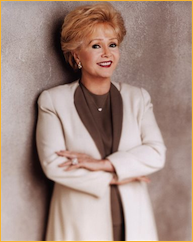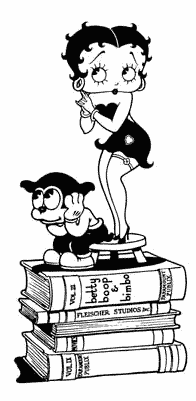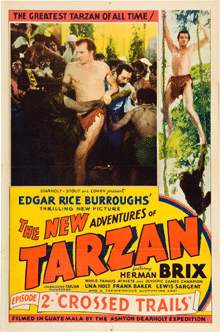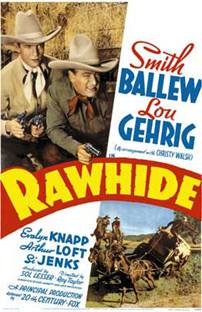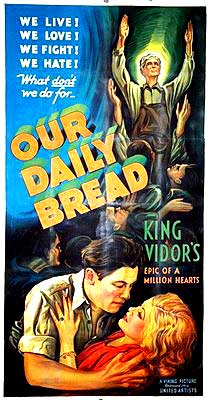 Victoria Balloon described how Betty MacDonald’s novel and Universal Picture’s screen version of The Egg and I inspired the 1950s Ma and Pa Kettle movie series. Victoria picks up where she left off and provides an engaging behind the scenes look at this pop culture phenomenon.
Victoria Balloon described how Betty MacDonald’s novel and Universal Picture’s screen version of The Egg and I inspired the 1950s Ma and Pa Kettle movie series. Victoria picks up where she left off and provides an engaging behind the scenes look at this pop culture phenomenon. In 1945 Betty Mac Donald’s “The Egg and I” was a wildly successful book, and in 1947 Universal Studios turned it into a successful film starring Claudette Colbert and Fred Mac Murray. While these two veteran actors brought a lighthearted comedic touch to their roles, it was a pair of secondary characters that became the favorites. Although Ma and Pa Kettle were only onscreen for 21 minutes, Marjorie Main’s gravel-voiced hollering and Percy Kilbride’s laconic replies made an indelible impression on urban and rural audiences alike. Main was nominated for Best Supporting Actress; Universal Studios and associate producer Leonard Goldstein sensed a goldmine.
 There were eight films that Main and Kilbride made together as Ma and Pa Kettle, including The Egg and I. They were upper-end B films, taking on average three weeks to make for $400,000 or less. The first three films made Universal $8 million, and the entire run made $35 million. Leonard Goldstein produced all but one of the subsequent films. It is said that the Ma and Pa Kettle films along with Francis the talking mule brought Universal back from the brink of ruin, and though the critics panned the Kettle films, audiences in both the city and the country laughed. Goldstein remarked wryly, “Nobody likes my pictures but the public.”
There were eight films that Main and Kilbride made together as Ma and Pa Kettle, including The Egg and I. They were upper-end B films, taking on average three weeks to make for $400,000 or less. The first three films made Universal $8 million, and the entire run made $35 million. Leonard Goldstein produced all but one of the subsequent films. It is said that the Ma and Pa Kettle films along with Francis the talking mule brought Universal back from the brink of ruin, and though the critics panned the Kettle films, audiences in both the city and the country laughed. Goldstein remarked wryly, “Nobody likes my pictures but the public.” The films built on one another as a sort of feature length serial. In Ma and Pa Kettle (1949) Pa enters a contest to win a free tobacco pouch and instead wins a futuristic Dream House with limitless technological comforts. The laughs center around Ma and Pa trying to figure out all the modern gadgets, while eldest Kettle Tom (Richard Long) has an on again off again romance with reporter Kim Parker (Meg Randall).
The films built on one another as a sort of feature length serial. In Ma and Pa Kettle (1949) Pa enters a contest to win a free tobacco pouch and instead wins a futuristic Dream House with limitless technological comforts. The laughs center around Ma and Pa trying to figure out all the modern gadgets, while eldest Kettle Tom (Richard Long) has an on again off again romance with reporter Kim Parker (Meg Randall).Pa no sooner gets the house figured out than he wins the Bubble-Ola Cola jingle contest and a trip to New York City. When Ma and Pa Kettle Go to Town (1950) they visit newlyweds Tom and Kim, who are having a few marital difficulties. A bank robber tries to dupe Pa into delivering stolen money to a gang in the city, but instead learns that there is no force more powerful than the destructive force of the Kettle Children.
With the help of Ma and Pa, Tom and Kim solve their differences, and in Ma and Pa Kettle Back on the Farm (1951), the first Kettle grandchild is born! Kim’s parents arrive from Boston to stay at the house, but Mrs. Parker’s controlling ways drive the Kettles back to their old place — which might have untold amounts of uranium on the property! Swindlers are foiled and snooty in-laws are won over by the folksy truths and innate goodness of the Kettle clan. Watch Ma & Pa spin their wheels racing a train in this zany clip.
 Having successfully married off the first son, Ma turns to the second child, Rosie, in Ma and Pa Kettle at the Fair (1952). In order to send her to college, Ma hopes to win prize money for her jams and quilt at the fair, but in the kind of mix ups that could only happen to the Kettles, she ends up entering their old horse in a harness race. In order to save the town from the possibility of immense gambling debts, Ma throws the race and… Well, it’s better if the Kettles leave town till things blow over.
Having successfully married off the first son, Ma turns to the second child, Rosie, in Ma and Pa Kettle at the Fair (1952). In order to send her to college, Ma hopes to win prize money for her jams and quilt at the fair, but in the kind of mix ups that could only happen to the Kettles, she ends up entering their old horse in a harness race. In order to save the town from the possibility of immense gambling debts, Ma throws the race and… Well, it’s better if the Kettles leave town till things blow over. As it turns out, some friends of Mr. and Mrs. Parker had to cancel their vacation plans, sending Ma and Pa Kettle on Vacation (1953) to Paris! Pa tries to “borrow” some pipe tobacco and instead gets involved with spies and murder. A true patriot, Pa is willing to help break up the international spy ring, but it’s Ma who shows us how to use an ash tray on the back of someone’s head.
As it turns out, some friends of Mr. and Mrs. Parker had to cancel their vacation plans, sending Ma and Pa Kettle on Vacation (1953) to Paris! Pa tries to “borrow” some pipe tobacco and instead gets involved with spies and murder. A true patriot, Pa is willing to help break up the international spy ring, but it’s Ma who shows us how to use an ash tray on the back of someone’s head.It’s the third son, Elwin, who needs to go to college this time in Ma and Pa Kettle at Home (1954). Elwin writes a marvelous essay about modern farming techniques, and it could land him a scholarship. The problem is, in order to award the final prize, the essay judges have to spend a week on the farm! Pa “borrows” from his neighbors to try to spruce up the place, but it’s the Kettle family’s Christmas spirit that teaches cranky neighbor John Maddocks and the judges what makes a farm a Home.
 In Ma and Pa Kettle at Waikiki (1955) we see where Elwin got his talent for embellishment. Pa’s been sending letters to his cousin in Hawaii telling him that he’s a big banking executive, so when Rodney Kettle’s pineapple farm runs into difficulties, it’s only natural that he ask “P.A. Kettle” to come to Waikiki and save the business. It’s possible that Pa has met his match this time — Papa Lotus (Charles Lung) may be even lazier than he is! Fortunately Mama Lotus (Hilo Hattie) and the 12 Lotus children team up with Ma Kettle to save Pa from rival corporate thugs. Pineapple will never taste the same.
In Ma and Pa Kettle at Waikiki (1955) we see where Elwin got his talent for embellishment. Pa’s been sending letters to his cousin in Hawaii telling him that he’s a big banking executive, so when Rodney Kettle’s pineapple farm runs into difficulties, it’s only natural that he ask “P.A. Kettle” to come to Waikiki and save the business. It’s possible that Pa has met his match this time — Papa Lotus (Charles Lung) may be even lazier than he is! Fortunately Mama Lotus (Hilo Hattie) and the 12 Lotus children team up with Ma Kettle to save Pa from rival corporate thugs. Pineapple will never taste the same. During this time Universal cartoons under the direction of Walter Lantz even introduced a brief series of animated “Maw and Paw” cartoons (1953-55). The first is an unabashed knock-off of the Ma and Pa Kettle movie: Milford the Pig (billed as “The Smart One”) oinks the answer to a radio show question and the family wins a modern car. The car’s gadgets give them no end of trouble until they run it into a tree, whereupon it is changed into a broken-down model-T, and the family is content. While the cartoons were never as popular as the films, audiences would have immediately recognized their source material.
During this time Universal cartoons under the direction of Walter Lantz even introduced a brief series of animated “Maw and Paw” cartoons (1953-55). The first is an unabashed knock-off of the Ma and Pa Kettle movie: Milford the Pig (billed as “The Smart One”) oinks the answer to a radio show question and the family wins a modern car. The car’s gadgets give them no end of trouble until they run it into a tree, whereupon it is changed into a broken-down model-T, and the family is content. While the cartoons were never as popular as the films, audiences would have immediately recognized their source material.The Ma and Pa Kettle films possess continuity in part because several of the supporting characters – Birdie Hicks and her perpetually unwell mother, fast talking salesman Billy Reed and several of the Kettle children — were introduced in The Egg and I and played by the same actors throughout the different films. However, the film depictions of these characters are very different from Betty MacDonald’s original versions. In her novel the Kettles are a composite of families MacDonald met during her time on the Olympic peninsula, and her descriptions are not flattering. On Ma Kettle:
Her whole front was dirty and spotted and she wiped her hands continually on one or other of her stomachs. She had also a disconcerting habit of reaching up under her dress and adjusting something in the vicinity of her navel and of reaching down the front of her dress and adjusting her large breasts. These adjustments were not, I learned later, confined to either the privacy of the house or a female gathering — they were made anywhere — any time. “I itch — so I scratch — so what!” was Mrs. Kettle's motto. (p. 114)
And on Pa Kettle’s method of “borrowing”:
Mr. Kettle broke the silence “Thingth ith putty tough thith year. [We learned the hard way that this was his stock approach to borrowing.] Yeth thir. Tough! The boys WON’T HELP MAW AND ME [his voice seemed to break bounds and rose and fell like the crescendos of a siren] and we can’t do it all alone and I GOT TWO THICK COWTH AND WE wondered if you folkth would give uth a hand becauth the boyth are working in the campth in the woodth logging and I CAN’T PLAOW ALONE AND THE OLD lady wondered if when you come down YOU WOULD BRING a little kerothine and a little pullet masth, ten cupth of FLOUR AND A FEW RAITHINS if you got ‘em.” (p. 118)
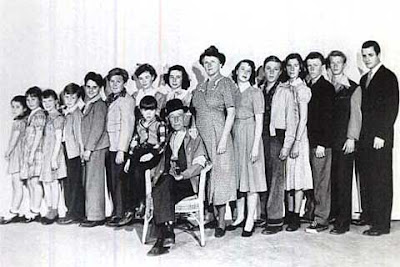
In the film versions, Ma and Pa’s oldest children are always well-groomed, intelligent and grammatical, but with the exception of Elwin (“A lank-haired mechanical genius”) and one of the Kettle’s daughters, Tits (“Even though Mrs. Kettle had already explained that the name Tits was short for sister, I found it impossible to hear the name without flinching”) MacDonald’s book dismisses the rest of the Kettles as “shiftless, ignorant and non-progressive but not important.” (p. 116) Clearly Ma and Pa Kettle became beloved characters not through MacDonald’s writing, but through the talents of the two wonderful character actors who portrayed them: Marjorie Man and Percy Kilbride.
 When Marjorie Main began her career in theater, she changed her name from Mary Tomlinson to avoid embarrassing her father, who was a minister. She worked the Chautauqua and Orpheum vaudeville circuits and debuted on Broadway in 1916. She stopped performing for a time when in 1921 she married Dr. Stanley LeFevre Krebs, a doctor of psychology, but with his permission she later returned to the stage and began to do film. In 1935 Dr. Krebs died, and it was one of her particular quirks that she never stopped communicating with Dr. Krebs, even after his death. She would speak — and listen to his replies — sometimes in the middle of filming a scene.
When Marjorie Main began her career in theater, she changed her name from Mary Tomlinson to avoid embarrassing her father, who was a minister. She worked the Chautauqua and Orpheum vaudeville circuits and debuted on Broadway in 1916. She stopped performing for a time when in 1921 she married Dr. Stanley LeFevre Krebs, a doctor of psychology, but with his permission she later returned to the stage and began to do film. In 1935 Dr. Krebs died, and it was one of her particular quirks that she never stopped communicating with Dr. Krebs, even after his death. She would speak — and listen to his replies — sometimes in the middle of filming a scene. She never remarried, and several authors in recent biographies have said that later in her life she had a long-term relationship with actress Spring Byington.
She never remarried, and several authors in recent biographies have said that later in her life she had a long-term relationship with actress Spring Byington.Main’s first film was A House Divided (1931), but her breakthrough films came from her re-creation of two of her Broadway roles: that of Baby Face Martin’s mother in Dead End (1937) and the down-to-earth landlady Lucy in The Women (1939).
 Hoping to recapture the chemistry between Wallace Beery and Marie Dressler, MGM paired Beery with Main in a string of 1940s comedies, beginning with Barnacle Bill. During this time Main played character roles in both big and small pictures, often as the mother of villains (Dark Command), matrons (The Harvey Girls), and housemaids (Meet Me in St. Louis).
Hoping to recapture the chemistry between Wallace Beery and Marie Dressler, MGM paired Beery with Main in a string of 1940s comedies, beginning with Barnacle Bill. During this time Main played character roles in both big and small pictures, often as the mother of villains (Dark Command), matrons (The Harvey Girls), and housemaids (Meet Me in St. Louis).Before The Egg and I, Main and Kilbride had never worked together. Some mistakenly include Feudin', Fussin' and A-Fightin' from 1948 as a Kettle movie, but though both Main and Kilbride were in it, they did not actually play Ma and Pa Kettle. Eventually Main came to admire him greatly. "I consider Percy the best dead-pan actor in the business," she declared, "And a complete gentleman."
 But for a man who played hundreds of roles in film, stock productions, and on Broadway, there isn’t a lot of biographical information on Percy Killbride. He was born in San Francisco to Irish-immigrant parents and was in theater since the age of eleven, beginning as an usher. His San Francisco theater career was put on hold by World War I; Kilbride was a Private in the army and served in France. His Broadway debut was in 1928 with The Buzzard, with his film debut as Jakey in White Woman five years later (1933). Like Pa Kettle, Percy Kilbride was a quiet, unassuming man. Unlike Pa Kettle, Kilbride dressed impeccably.
But for a man who played hundreds of roles in film, stock productions, and on Broadway, there isn’t a lot of biographical information on Percy Killbride. He was born in San Francisco to Irish-immigrant parents and was in theater since the age of eleven, beginning as an usher. His San Francisco theater career was put on hold by World War I; Kilbride was a Private in the army and served in France. His Broadway debut was in 1928 with The Buzzard, with his film debut as Jakey in White Woman five years later (1933). Like Pa Kettle, Percy Kilbride was a quiet, unassuming man. Unlike Pa Kettle, Kilbride dressed impeccably. In 1942 when Warner Brothers wanted to do a film version of the popular play George Washington Slept Here, they cast Jack Benny as the caretaker, Mr. Kimber. Benny went to New York to see the play for himself and was bowled over by Kilbride’s understated comic performance. Benny insisted Kilbride play the role of Mr. Kimber in the film version (which worked out well for him, because Benny got the lead). Several takes were ruined because Benny could not stop laughing at Kilbride’s deadpan delivery. At 54, Kilbride’s film career began in earnest; he too became a character actor, playing the closed mouthed (Keeper of the Flame), plain country type (State Fair).
In 1942 when Warner Brothers wanted to do a film version of the popular play George Washington Slept Here, they cast Jack Benny as the caretaker, Mr. Kimber. Benny went to New York to see the play for himself and was bowled over by Kilbride’s understated comic performance. Benny insisted Kilbride play the role of Mr. Kimber in the film version (which worked out well for him, because Benny got the lead). Several takes were ruined because Benny could not stop laughing at Kilbride’s deadpan delivery. At 54, Kilbride’s film career began in earnest; he too became a character actor, playing the closed mouthed (Keeper of the Flame), plain country type (State Fair). MacDonald’s book takes place on the Olympic peninsula in Washington state, but aside from a brief scene of a stationmaster reading The Seattle Times and fleeting references to Cape Flattery, The Egg and I and to a greater degree, the Kettle films, seem to unfold in a Rural America that is vaguely New England (Kilbride’s accent) vaguely Western (there are Indians) and vaguely Southern (the Kettle’s ramshackle home). This is undoubtedly intentional on the part of Universal. The Kettle films were part of a long line of hillbilly-themed entertainment that began in the late 1920s and became popularized in the 1930s. The term “hillbilly” is of uncertain origin, but one theory is that it was a combination of the Scotch-Irish “hill-folk” and “billy,” a term meaning “fellow” or “guy.”
MacDonald’s book takes place on the Olympic peninsula in Washington state, but aside from a brief scene of a stationmaster reading The Seattle Times and fleeting references to Cape Flattery, The Egg and I and to a greater degree, the Kettle films, seem to unfold in a Rural America that is vaguely New England (Kilbride’s accent) vaguely Western (there are Indians) and vaguely Southern (the Kettle’s ramshackle home). This is undoubtedly intentional on the part of Universal. The Kettle films were part of a long line of hillbilly-themed entertainment that began in the late 1920s and became popularized in the 1930s. The term “hillbilly” is of uncertain origin, but one theory is that it was a combination of the Scotch-Irish “hill-folk” and “billy,” a term meaning “fellow” or “guy.” As the American frontier pushed westward after the Civil War, the Appalachian region remained largely unchanged, rural and isolated because of its rough terrain. Short-stories and features in popular magazines like Scribner’s and Harper’s New Monthly Magazine depicted the region and its inhabitants as part of a backwards “otherness” existing in nineteenth-century America while the rest of the nation embraced modern industrialization. The famous feud of the Hatfields versus the McCoys in 1880 fueled the idea of quick-tempered mountain men, and by the 1930s the stereotypes of a people alternately atavistic and ridiculous were cemented into popular culture with Paul Webb’s illustrations in Esquire magazine.
As the American frontier pushed westward after the Civil War, the Appalachian region remained largely unchanged, rural and isolated because of its rough terrain. Short-stories and features in popular magazines like Scribner’s and Harper’s New Monthly Magazine depicted the region and its inhabitants as part of a backwards “otherness” existing in nineteenth-century America while the rest of the nation embraced modern industrialization. The famous feud of the Hatfields versus the McCoys in 1880 fueled the idea of quick-tempered mountain men, and by the 1930s the stereotypes of a people alternately atavistic and ridiculous were cemented into popular culture with Paul Webb’s illustrations in Esquire magazine.Why were hillbillies and hillbilly culture so popular with Depression-Era audiences? Very possibly because the overwhelming feature of 1930s America was unemployment. As one scholar puts it: “The early 1930s forced middle-class urban Americans to consider seriously the unthinkable possibility that the whole damn shooting match of the American economic system itself was about to land them back in Rural Subsistence Hell.” Most Americans left farming a generation ago; the prospect of being driven back to it by economic hardship was gloomy indeed.
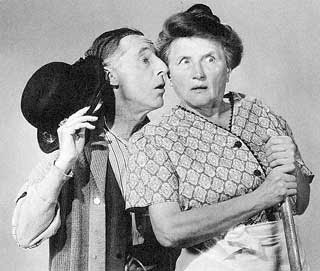 Depression audiences loved any entertainments that allowed them to escape fear through laughter, and caricatures and stereotypes of many groups, including hillbillies, were abundant. Urban audiences could take smug pleasure in laughing at hillbillies as “other;” rural folks could laugh at them as somebody even dumber than they were often portrayed. Both urban and rural audiences could feel better about the economic system that had them at their mercy; so long as somebody was beneath them, they must be moving up.
Depression audiences loved any entertainments that allowed them to escape fear through laughter, and caricatures and stereotypes of many groups, including hillbillies, were abundant. Urban audiences could take smug pleasure in laughing at hillbillies as “other;” rural folks could laugh at them as somebody even dumber than they were often portrayed. Both urban and rural audiences could feel better about the economic system that had them at their mercy; so long as somebody was beneath them, they must be moving up.The 1930s had a whole host of entertainments featuring backwoods humor. Radio shows like Lum and Abner and The Grand Ole Opry began nationwide broadcasting in 1932. Comic strips such as Al Capp’s Lil’ Abner and Billy De Beck’s Snuffy Smith appeared in 1934. There were animated hillbilly cartoons such as Friz Freeling’s When I Yoo Hoo (1936), Tex Avery’s A Feud There Was (1938) and Bob Clampett’s Naughty Neighbors (1939). Even Max Fleischer’s Betty Boop managed some down-home clogging in Musical Mountaineers (1939).
 But after World War II the stereotype of the inbred, feral, regressive hillbilly was seen as more offensive. Many people from Appalachian left the region for Mid-Atlantic and Midwestern cities to work in wartime factories; the stereotypes of the quick tempered, drunken, lascivious ne’er do well of sub-human intelligence were not appreciated.
But after World War II the stereotype of the inbred, feral, regressive hillbilly was seen as more offensive. Many people from Appalachian left the region for Mid-Atlantic and Midwestern cities to work in wartime factories; the stereotypes of the quick tempered, drunken, lascivious ne’er do well of sub-human intelligence were not appreciated.Though the films retained some stereotypes (naiveté, disregard for strict hygiene, and an aversion to physical labor) Ma and Pa Kettle were less about hillbilly caricature and more a commentary on post-war values, emphasizing the importance of large, nuclear families and sacrifice for one’s children (even if Ma can’t keep their names straight). With humor combining ridicule and empathy, audiences could laugh at the bumbling pair out of place in modern cities like Paris and New York, and even their own Dream Home.
 Though Ma and Pa were slovenly, lethargic and completely without middle class proprieties, they appealed to a post-War America also increasingly uncomfortable with the pace of modern life. Producer Goldstein reflected, “Maybe people feel a little superior and maybe at the same time they recognize a lot of things about themselves,” and Kilbride himself said, “Anybody, even the lowliest bum, can feel superior to the Kettles.” Even now we can laugh at and enjoy these films because we see that the Kettles are basically good people. They love their kids and each other, and no matter how ridiculous the scrapes they get into because of their naïve outlook on life, it is that same unmodernized goodness that sees them through to triumph.
Though Ma and Pa were slovenly, lethargic and completely without middle class proprieties, they appealed to a post-War America also increasingly uncomfortable with the pace of modern life. Producer Goldstein reflected, “Maybe people feel a little superior and maybe at the same time they recognize a lot of things about themselves,” and Kilbride himself said, “Anybody, even the lowliest bum, can feel superior to the Kettles.” Even now we can laugh at and enjoy these films because we see that the Kettles are basically good people. They love their kids and each other, and no matter how ridiculous the scrapes they get into because of their naïve outlook on life, it is that same unmodernized goodness that sees them through to triumph. However, the comedic premise of the Kettles can only go so far. Once Universal sent Ma and Pa to Hawaii, where else could they go? After Ma and Pa Kettle at Waikiki, Percy Kilbride retired, possibly because of early symptoms of Alzheimer's disease. There were two Kettle movies without Kilbride: The Kettles in the Ozarks (1956) (with Arthur Hunnicutt as Pa’s brother Sedgewick Kettle) and The Kettles on Old MacDonald's Farm (1957) (with Parker Fennelly as Pa Kettle) but without Kilbride, neither one can truly be called a Ma and Pa Kettle film.
However, the comedic premise of the Kettles can only go so far. Once Universal sent Ma and Pa to Hawaii, where else could they go? After Ma and Pa Kettle at Waikiki, Percy Kilbride retired, possibly because of early symptoms of Alzheimer's disease. There were two Kettle movies without Kilbride: The Kettles in the Ozarks (1956) (with Arthur Hunnicutt as Pa’s brother Sedgewick Kettle) and The Kettles on Old MacDonald's Farm (1957) (with Parker Fennelly as Pa Kettle) but without Kilbride, neither one can truly be called a Ma and Pa Kettle film.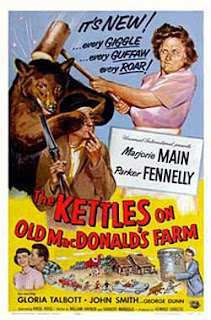 The Kettles on Old MacDonald's Farm was the final feature for Marjorie Main. She made a few television appearances, enjoyed riding in the Hollywood Christmas parade, and died in 1975 at 85. In 1964 Kilbride and friend actor Ralf Belmont were crossing a street in Hollywood when both were struck by a speeding car. Belmont was killed instantly, but Kilbride survived. Brain surgery could not save him; he died weeks later of pneumonia and his injuries at age 76.
The Kettles on Old MacDonald's Farm was the final feature for Marjorie Main. She made a few television appearances, enjoyed riding in the Hollywood Christmas parade, and died in 1975 at 85. In 1964 Kilbride and friend actor Ralf Belmont were crossing a street in Hollywood when both were struck by a speeding car. Belmont was killed instantly, but Kilbride survived. Brain surgery could not save him; he died weeks later of pneumonia and his injuries at age 76. While it is fascinating to study how images of rural life and the hillbilly came to be a part of American popular culture, ultimately one cannot dissect what an audience of a particular time and place calls comedy. the 1960s television series Green Acres and The Beverly Hillbillies were direct descendants of The Egg and I and the Ma and Pa Kettle films , and they also relied on the comedy of the “fish out of water” — either putting the country folk into a mansion, or putting the naïve city dweller back on the farm.
While it is fascinating to study how images of rural life and the hillbilly came to be a part of American popular culture, ultimately one cannot dissect what an audience of a particular time and place calls comedy. the 1960s television series Green Acres and The Beverly Hillbillies were direct descendants of The Egg and I and the Ma and Pa Kettle films , and they also relied on the comedy of the “fish out of water” — either putting the country folk into a mansion, or putting the naïve city dweller back on the farm.The appeal of the “fish out of water” comedy, and ultimately the Kettles, lies partly in the story, but in large part lies in the incredible talents of Main and Kilbride, who brought the characters to life. Simply put, when MacDonald’s version of Ma Kettle scratches herself, it’s disgusting; when Marjorie Main’s version does it, it’s funny.
Now that’s comedy, folks.
_________________
For Further Reading:
Anthony Harkins, “Hillbilly: A Cultural History of an American Icon.” Oxford University Press US, 2005. Tim Hollis, “Ain't That a Knee-Slapper: Rural Comedy in the Twentieth Century.” Univ. Press of Mississippi, 2008. Jerry Wayne Williamson, "Hillbillyland: What the Movies Did to the Mountains and What the Mountains Did to the Movies.” UNC Press, 1995.
Betty MacDonald’s book, “The Egg and I” is a bitingly witty and entertaining read; however, published in 1945, it does contain all the racial prejudices of its day. It can be found at Amazon.com, or even at your local library (All quotes were taken from the original 1945 edition).
Period movie reviews are always interesting. Read what the critics at the New York Times thought of Ma and Pa Kettle, Ma and Pa Kettle Back on the Farm, and Ma and Pa Kettle at the Fair. Notice that at one of the movie openings Percy Kilbride performed live onstage! The Adventures of Ma and Pa Kettle Volumes 1 and 2 can be purchased online at Turner Classic Movies.
Watch this wonderful bit of down-home logic as Ma and Pa Kettle show Billy Reed how to do math in Ma and Pa Kettle Back on the Farm (1951)















